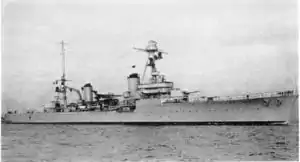French cruiser Dupleix (1930)
Dupleix was a French heavy cruiser of the Suffren class, that saw service during World War II. She was named for the 18th century Governor-General of French India, Joseph François Dupleix.
 Dupleix | |
| History | |
|---|---|
| Name: | Dupleix |
| Namesake: | Joseph François Dupleix |
| Builder: | Arsenal de Brest |
| Laid down: | 14 November 1929 |
| Launched: | 9 October 1930 |
| Commissioned: | 7 July 1932 |
| Fate: | Scuttled at Toulon, 27 November 1942, Scrapped 1951 |
| General characteristics | |
| Class and type: | Suffren-class cruiser |
| Displacement: |
|
| Length: | 196 m (643.04 ft) |
| Beam: | 20 m (65.62 ft) |
| Draught: | 7.3 m (23.95 ft) |
| Installed power: |
|
| Propulsion: | 3 shafts; geared steam turbines |
| Speed: | 32 knots (59 km/h; 37 mph) |
| Range: | 4,500 nautical miles (8,300 km; 5,200 mi) at 15 knots (28 km/h; 17 mph) |
| Complement: | 773 |
| Armament: |
|
| Armour: |
|
| Aircraft carried: | 2 Loire-Nieuport 130 |
| Aviation facilities: | 2 catapults |
Design and description
The design of the Suffren class was derived from the preceding Duquesne class with more armor exchanged for less speed. The ships had an overall length of 194 meters (636 ft 6 in), a beam of 19.26 meters (63 ft 2 in), and a draft of 6.57 meters (21 ft 7 in). They displaced 10,160 metric tons (10,000 long tons) at standard load and 13,135–13,644 t (12,928–13,429 long tons) at deep load. The hull was divided by 18 bulkheads into 19 watertight compartments. Their crew normally consisted of 647 men and increased by 84 when serving as flagships.[1]
Construction and career
She was commissioned on 7 July 1932 and based in Toulon, as part of the 1st light division of the 1st squadron. In 1937, she was completely refitted. From 14 October 1939 to the end of January 1940, along with the cruiser Algérie, she was part of Force X based in Dakar.
While on patrol in the Atlantic with the destroyers, Le Fantasque and Le Terrible, she intercepted and captured the German freighter Santa Fé, on 25 October 1939, On 14 June 1940, Dupleix participated in the French raid on Genoa, with sister ships Foch and Colbert.
After the surrender of France to Nazi Germany, Dupleix remained with the Vichy Fleet at Toulon. When the Germans occupied Vichy France, she was among those ships that took part in the scuttling of the French fleet in Toulon. German officers, attempting to take the ship intact, rushed aboard and forced the French crew below decks, and successfully located and closed the sea valves. The ship's captain, capitaine de vaisseau Moreau, ordered the scuttling charges in the main turrets to be lit with shortened fuses and when they exploded and fires took hold, Moreau ordered the final evacuation. French and Germans aboard all fled the vessel. Explosions of the ship's torpedo stores destroyed the vessel, which burned for 10 days.
Refloated in two sections on 3 July 1943 by Italian salvage teams; the two halves were hit by Allied bombs on 11 March 1944, the bow sinking immediately and the stern on 15 March. The remains were broken up in situ in 1951.
In 1935 the Marine Nationale co-operated with a film company for the production of Veille d'armes, directed by Marcel L'Herbier, a romantic melodrama about a captain in the French Navy. The cruiser Dupleix was made available for location shooting in and around its base in Toulon, and L'Herbier sought to incorporate into the drama as much detail as possible about the ship and its procedures.[2]
Citations
- Jordan & Moulin, pp. 50, 71–72
- Interview with Mireille Beaulieu, included with DVD of Veille d'armes released by Les Documents Cinématographiques (Paris) in 2014.
References
- Jordan, John & Moulin, Jean (2013). French Cruisers 1922–1956. Barnsley, UK: Seaforth Publishing. ISBN 978-1-84832-133-5.
- Saibène, Marc (n.d.). Toulon et la Marine 1942–1944. Bourg en Bresse: Marines Editions at Realisations.